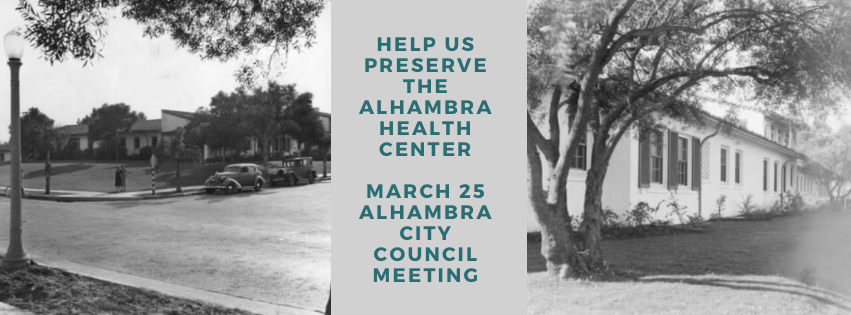
An important decision will be made this coming Monday night (March 25, 2024) about one of Alhambra’s most significant historic buildings. Your input will be vital!
Voice your support for the preservation of the historic Alhambra Health Center (located at 612 West Shorb Street, Alhambra, CA 91803) at the upcoming Monday, March 25, 2024 Alhambra City Council meeting. Here are the specifics:
Date: Monday, March 25, 2024
Time: 6:00 p.m.
Location: Alhambra City Hall, 101 South 1st Street, Alhambra, CA 91801 or online
Item 2: Alhambra Community Center Design Update
The City Council meeting agenda may be found here. The packet for Item 2 begins on Page 12 of the agenda. Renderings for the various proposed designs may be found below.
Please plan on attending either in person or via Zoom.
What Will Alhambra City Council Consider on March 25?
City Council will consider design options for completing the Environmental Impact Report (EIR) project description for a new community center to be built on the site of the former Alhambra Health Center at 612 W. Shorb Street, Alhambra. City and consultant staff will present four options, two new building designs, which both call for the demolition of the current Alhambra Health Center, and two reuse designs, which call for the preservation of all or a portion of the two-story structure. The proposed new designs are named Scheme I “Around the CampFire” and Scheme II “Overlooks”. The proposed adaptive reuse designs are named Alternative I “Flowscapes”; and Alternative II “Connecting Gems”.
We are pleased that the two proposed reuse design alternatives (Flowscapes and Connecting Gems) support the preservation of the two-story north facing portion of the original Alhambra Health Center.
Alhambra Historical Society and Alhambra Preservation Group representatives have reviewed the proposed design proposals. We support reuse design Alternative II “Connecting Gems” and have sent a joint letter to the City Council encouraging them to vote for and adopt Alternative II. The joint letter may be viewed here.
Design Alternative II is a good compromise for the community center project. It is concurrently equitable in cost compared to the previously presented two new building designs and preserves and adaptively reuses the most historically significant portion of the Alhambra Health Center. Additionally, the layout includes a great room, spaces for community programming and provides additional parking spaces, furnishing much-needed parking relief for the surrounding Mayfair tract community.
How Can You Help?
We encourage you to attend the March 25 City Council Meeting and voice your support for design Alternative II “Connecting Gems” for the Alhambra Community Center.
You may attend the City Council meeting either in person or via Zoom.
In Person: If you are attending the March 25 Alhambra City Council meeting at City Hall in person, fill out a blue speaker card for Item 2 and submit it to the City Clerk prior to the start of the meeting.
Via Zoom: If you are attending the March 25 Alhambra City Council meeting via Zoom, use the “Raise Hand” feature during the public comments for Item 2. The “Raise Hand” feature may be found under Reactions on the Zoom app interface. The Zoom link may be found in the March 25 agenda.
Your attendance and vocal support of design Alternative II is imperative and will demonstrate a groundswell of support to preserve the Alhambra Health Center for adaptive reuse. It will also communicate to Alhambra leaders the importance of protecting and preserving this historic resource, which is eligible for listing on the National Register of Historic Places.
Do you have suggested speaking points?
Yes. Suggested speaking points can be found below. Please feel free to revise, but remember to keep your comments to five minutes and speak respectfully.
If you have any questions, please email alhambrahistsoc@att.net. We hope to see you at the Alhambra City Council meeting on March 25!
Thank you for your ongoing support!
——————————————————————————————————-
SUGGESTED SPEAKING POINTS
MARCH 25 ALHAMBRA CITY COUNCIL MEETING
Good evening Mayor Maza, Alhambra City Council Members and City staff:
My name is __________________________ and I am a resident of Alhambra.
I am here to voice my support for reuse Alternative II “Connecting Gems” for the proposed Alhambra Community Center, which would preserve the most historically and architecturally significant portion of the Alhambra Health Center and adaptively reuse it as a community center.
Design Alternative II signifies a win-win-win for the community. It preserves the most architecturally significant portion of the Alhambra Health Center which eligible for the National Register of HIstoric Places, is financially feasible and gives Alhambra the community center it needs.
The Alhambra Health Center has been a part of the Alhambra community since 1930. Like many Alhambrans, I look forward to seeing this historic resource given new life and purpose as a vibrant community center. Its listing on the California Register of Historical Resources and eligibility for National Register of Historic Places status merits its preservation and adaptive reuse.
By voting for design Alternative II you will be honoring your unanimous 2021 decision to preserve as much of the original Alhambra Health Center as possible in the design of the community center. A vote for design Alternative II will also be consistent with your strategic planning goal of developing a comprehensive historic preservation program and prioritizing the protection and preservation of Alhambra’s historical, architectural and cultural resources.
I respectfully request that you adopt design Alternative II “Connecting Gems” for the proposed Alhambra Community Center project. Thank you for listening and your consideration.
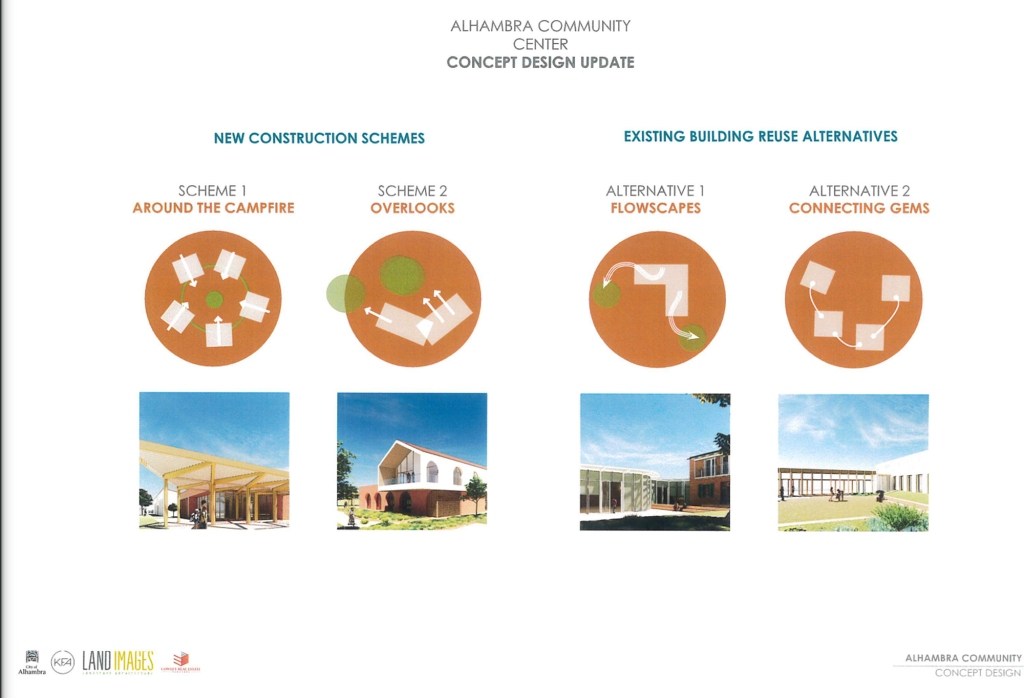


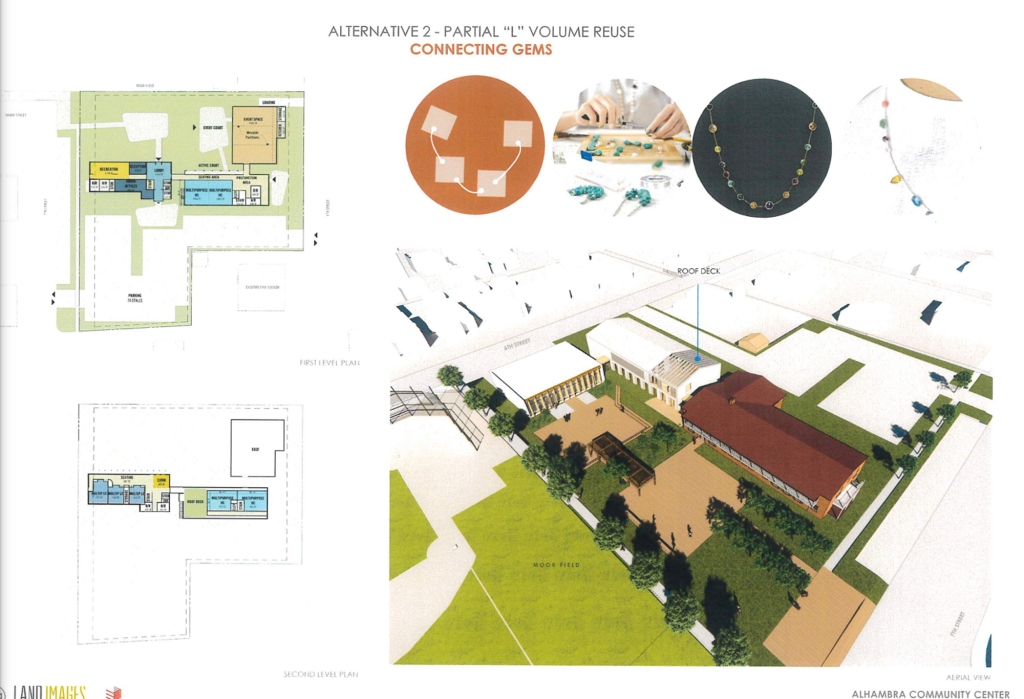
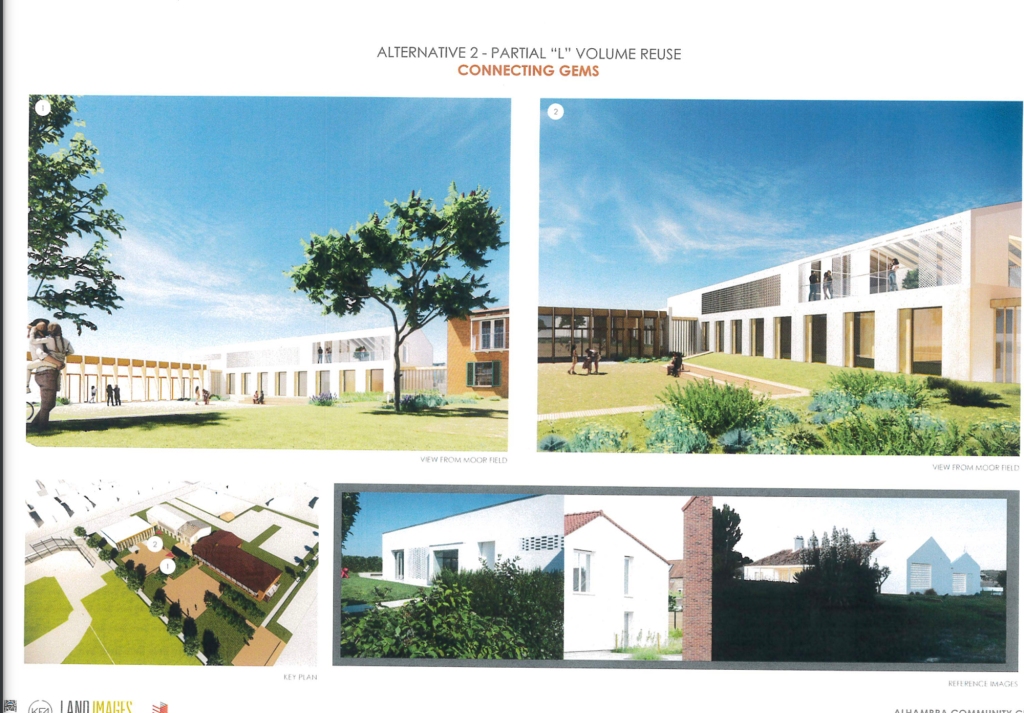

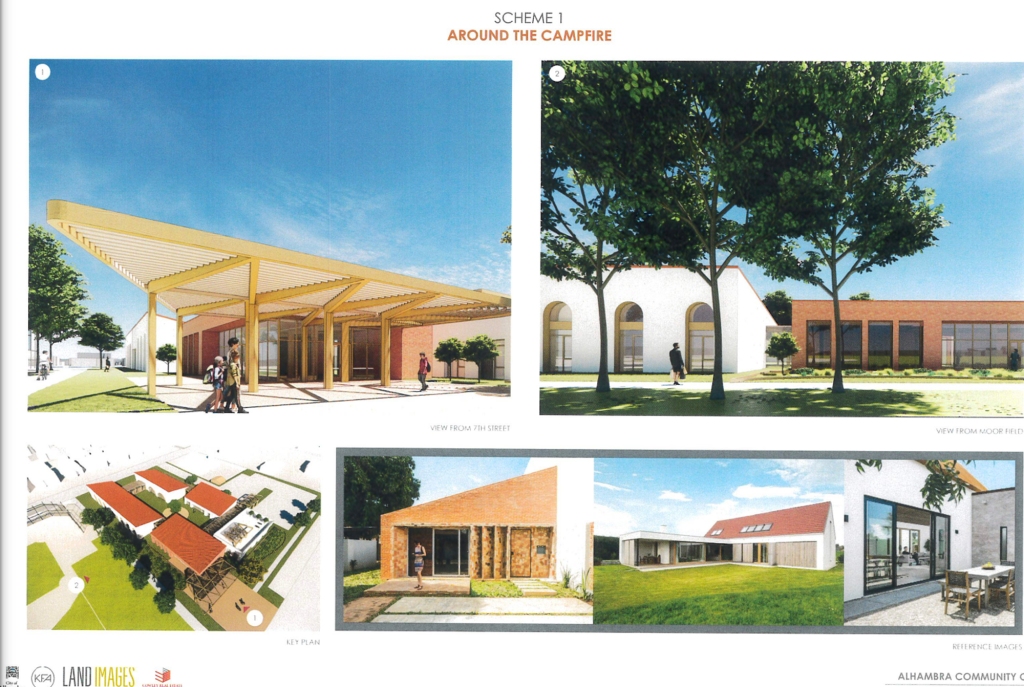
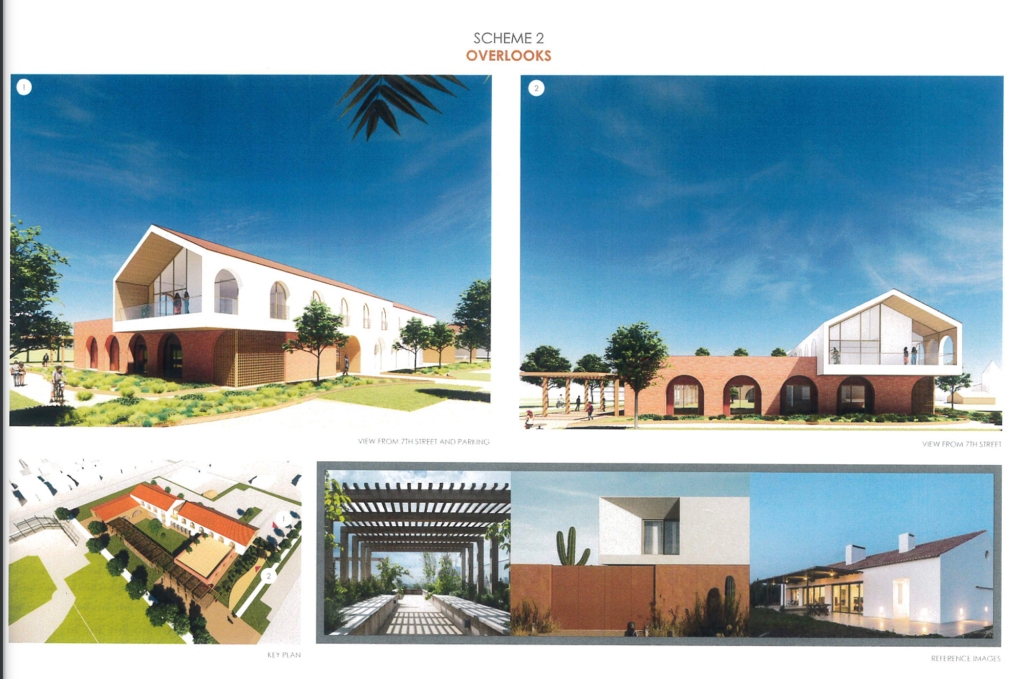
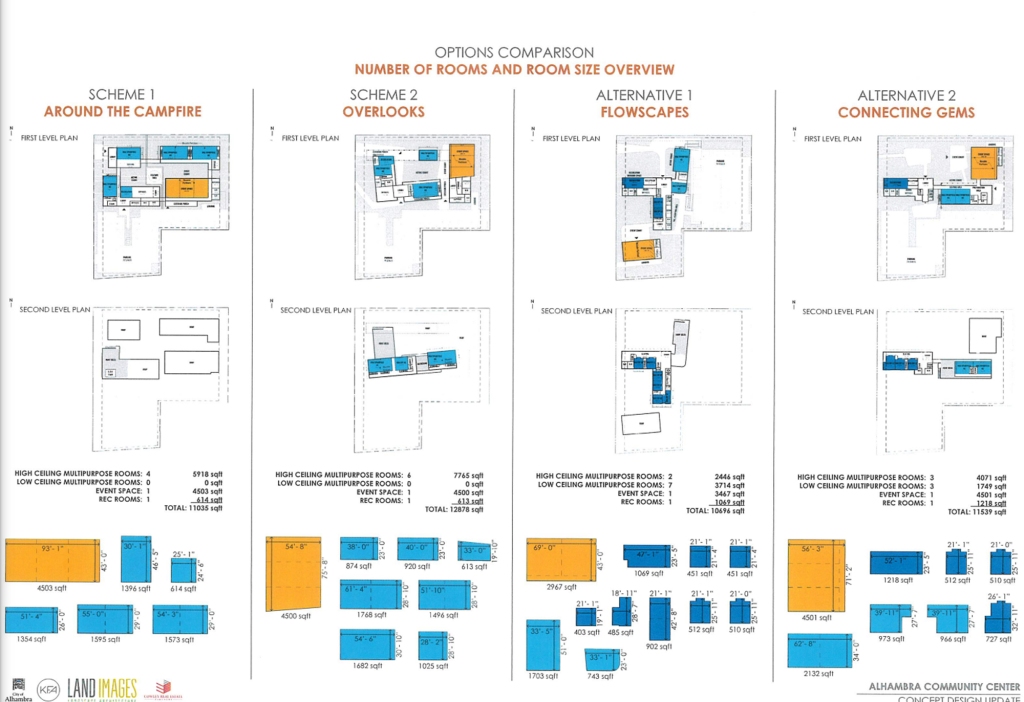
 The City of Alhambra is taking its first steps toward the development of a historic preservation program, and we need you to be there…from the comfort of your own home! We’ve counted on you in the past and you’ve been there for us, for our communities and for preserving our city’s collection of historic homes.
The City of Alhambra is taking its first steps toward the development of a historic preservation program, and we need you to be there…from the comfort of your own home! We’ve counted on you in the past and you’ve been there for us, for our communities and for preserving our city’s collection of historic homes. We need your help to save one of Alhambra’s few remaining Bungalow Courts and a Craftsman home.
We need your help to save one of Alhambra’s few remaining Bungalow Courts and a Craftsman home.
 Constructed in 1929 at a cost of $160,000, the building was designed by LA Gas Company architects and engineers to evoke the period of the Italian Renaissance. Arched window and door openings predominate, with a glazed terra cotta base surmounted with varied-colored brick in harmonizing shades.
Constructed in 1929 at a cost of $160,000, the building was designed by LA Gas Company architects and engineers to evoke the period of the Italian Renaissance. Arched window and door openings predominate, with a glazed terra cotta base surmounted with varied-colored brick in harmonizing shades. Newspapers of the day raved about the impressive design and architecture of the building. The first floor contained the main lobby and corporate business offices, manager’s office, investigation room, vault, and distribution department offices.
Newspapers of the day raved about the impressive design and architecture of the building. The first floor contained the main lobby and corporate business offices, manager’s office, investigation room, vault, and distribution department offices.
 this type and style of architecture, the convent was described in the Pasadena Post upon its opening on June 24, 1923 as “one of the finest in the United States”. A classically articulated portal of pre-cast concrete defines the monastery’s entrance. The first floor of the convent is defined by loggias at the south and west elevations, which overlook a broad expanse of lawn and garden.
this type and style of architecture, the convent was described in the Pasadena Post upon its opening on June 24, 1923 as “one of the finest in the United States”. A classically articulated portal of pre-cast concrete defines the monastery’s entrance. The first floor of the convent is defined by loggias at the south and west elevations, which overlook a broad expanse of lawn and garden. Alhambra’s Carmelite Monastery was designed by one of Southern California’s most prominent architects. John C. Austin was born in England in 1870, immigrating to California in the 1890’s. He established an architectural practice in Los Angeles in 1895. Austin was very active in local civic affairs, serving as President of the Los Angeles Chamber of Commerce, the Southern California Historical Society, and the Jonathan Club, as well as the California Board of Architectural Examiners. He designed some of the most famous and easily-recognized landmark buildings in the Los Angeles area, many of which are listed on the National Register of Historic Places. Among these distinguished buildings are the Los Angeles City Hall, the Shrine Auditorium, and the Griffith Observatory.
Alhambra’s Carmelite Monastery was designed by one of Southern California’s most prominent architects. John C. Austin was born in England in 1870, immigrating to California in the 1890’s. He established an architectural practice in Los Angeles in 1895. Austin was very active in local civic affairs, serving as President of the Los Angeles Chamber of Commerce, the Southern California Historical Society, and the Jonathan Club, as well as the California Board of Architectural Examiners. He designed some of the most famous and easily-recognized landmark buildings in the Los Angeles area, many of which are listed on the National Register of Historic Places. Among these distinguished buildings are the Los Angeles City Hall, the Shrine Auditorium, and the Griffith Observatory.
 C F Braun & Co. moved its international headquarters to Alhambra from San Francisco in 1921. The complex included towering brick walls, 22 buildings and a landscaped plaza on 36 acres. The primary building material for this “modern office complex” was brick – all purchased from the same San Francisco manufacturer. Braun was a practical man, an engineer, who didn’t hesitate to move or modify buildings — or to build new ones — according to the nature of the work in which the company was involved and the functional needs of its various manufacturing projects. The significance — and the beauty — of this campus is that, through dozens of modifications and 92 years of operation, purposeful attention to architectural character and detail has preserved the integrated whole.
C F Braun & Co. moved its international headquarters to Alhambra from San Francisco in 1921. The complex included towering brick walls, 22 buildings and a landscaped plaza on 36 acres. The primary building material for this “modern office complex” was brick – all purchased from the same San Francisco manufacturer. Braun was a practical man, an engineer, who didn’t hesitate to move or modify buildings — or to build new ones — according to the nature of the work in which the company was involved and the functional needs of its various manufacturing projects. The significance — and the beauty — of this campus is that, through dozens of modifications and 92 years of operation, purposeful attention to architectural character and detail has preserved the integrated whole. C F Braun & Co.’s interior offices featured wood paneling and were “pleasingly appointed and well-lighted” as described in a promotional brochure. It had every amenity needed for a modern manufacturing plant including a state-of-the-art engineering library, woman’s lounge, men’s locker room, a restaurant and a medical office staffed by an on-site physician. Mr. Braun’s goal was to “provide comfortable and pleasant surroundings for its workers, of every class, that they may have pleasure in their work and pride in their plant and product.” He took a great deal of pride in the “modern workplace” that he created.
C F Braun & Co.’s interior offices featured wood paneling and were “pleasingly appointed and well-lighted” as described in a promotional brochure. It had every amenity needed for a modern manufacturing plant including a state-of-the-art engineering library, woman’s lounge, men’s locker room, a restaurant and a medical office staffed by an on-site physician. Mr. Braun’s goal was to “provide comfortable and pleasant surroundings for its workers, of every class, that they may have pleasure in their work and pride in their plant and product.” He took a great deal of pride in the “modern workplace” that he created.
 “We wanted to bring the ‘Wow!’ factor back,” explained Regina Cipriani, a lifelong Alhambra resident, explained. “Now, when you open the door, you see all the wood detailing that make Craftsman homes so stunning.
“We wanted to bring the ‘Wow!’ factor back,” explained Regina Cipriani, a lifelong Alhambra resident, explained. “Now, when you open the door, you see all the wood detailing that make Craftsman homes so stunning.
 The home also revealed surprises. A now mostly illegible message written in pencil on the plaster in the rear bedroom dated August 1912 with the name “Schmidt” and “good night,” was found hidden under wallpaper.
The home also revealed surprises. A now mostly illegible message written in pencil on the plaster in the rear bedroom dated August 1912 with the name “Schmidt” and “good night,” was found hidden under wallpaper. An original Craftsman-style light fixture pendant was discovered in the basement. Probably one of the 10 fixtures that originally hung from the living room beams, and a match to the existing fixture in the library. It was rewired and now hangs in the breakfast room. “You think you know a house. But with these beautiful old Craftsman homes, there is still a lot to discover.”
An original Craftsman-style light fixture pendant was discovered in the basement. Probably one of the 10 fixtures that originally hung from the living room beams, and a match to the existing fixture in the library. It was rewired and now hangs in the breakfast room. “You think you know a house. But with these beautiful old Craftsman homes, there is still a lot to discover.” When Lindaraxa Park was first developed in the early 20th Century, Alhambra was a vastly different city. Like many surrounding communities, Alhambra was comprised of orange orchards with large Victorian farmhouses dotting the landscape. Lindaraxa Park was no different. Originally a portion of the Alhambra Tract, which was purchased by Alhambra’s founder, Benjamin “Don Benito” Wilson in 1854, the area was filled with citrus orchards belonging to Sunkist founder, Francis Q. Story.
When Lindaraxa Park was first developed in the early 20th Century, Alhambra was a vastly different city. Like many surrounding communities, Alhambra was comprised of orange orchards with large Victorian farmhouses dotting the landscape. Lindaraxa Park was no different. Originally a portion of the Alhambra Tract, which was purchased by Alhambra’s founder, Benjamin “Don Benito” Wilson in 1854, the area was filled with citrus orchards belonging to Sunkist founder, Francis Q. Story. This area located in northeast Alhambra was sub-divided and developed in the early 20th century by the Alhambra Construction Company. Elaborate full-page advertisements in a special holiday advertising section of the Alhambra Advocate generated interest. In keeping with the city’s use of Moorish names, the new development was named Court Lindaraxa. This name was taken from Washington Irving’s book Tales of the Alhambra, from which Alhambra was named. Lindaraxa was a Moorish princess who had an apartment and garden in the Alhambra, a Medieval palace located in Granada, Spain.
This area located in northeast Alhambra was sub-divided and developed in the early 20th century by the Alhambra Construction Company. Elaborate full-page advertisements in a special holiday advertising section of the Alhambra Advocate generated interest. In keeping with the city’s use of Moorish names, the new development was named Court Lindaraxa. This name was taken from Washington Irving’s book Tales of the Alhambra, from which Alhambra was named. Lindaraxa was a Moorish princess who had an apartment and garden in the Alhambra, a Medieval palace located in Granada, Spain. We’re all well into our 2017 new year resolutions by now, and no doubt, some resolutions are proving harder to keep than others. So to make things a bit easier, here are two simple ways to support your community and Alhambra Preservation Group in the new year:
We’re all well into our 2017 new year resolutions by now, and no doubt, some resolutions are proving harder to keep than others. So to make things a bit easier, here are two simple ways to support your community and Alhambra Preservation Group in the new year: by Joyce Amaro, President
by Joyce Amaro, President How much do you really know about historic preservation? In this two-part series, we explore the myths surrounding preservation. In this article, we bust preservation myths at large. In the second article, we’ll dispel preservation myths specific to the city of Alhambra.
How much do you really know about historic preservation? In this two-part series, we explore the myths surrounding preservation. In this article, we bust preservation myths at large. In the second article, we’ll dispel preservation myths specific to the city of Alhambra.